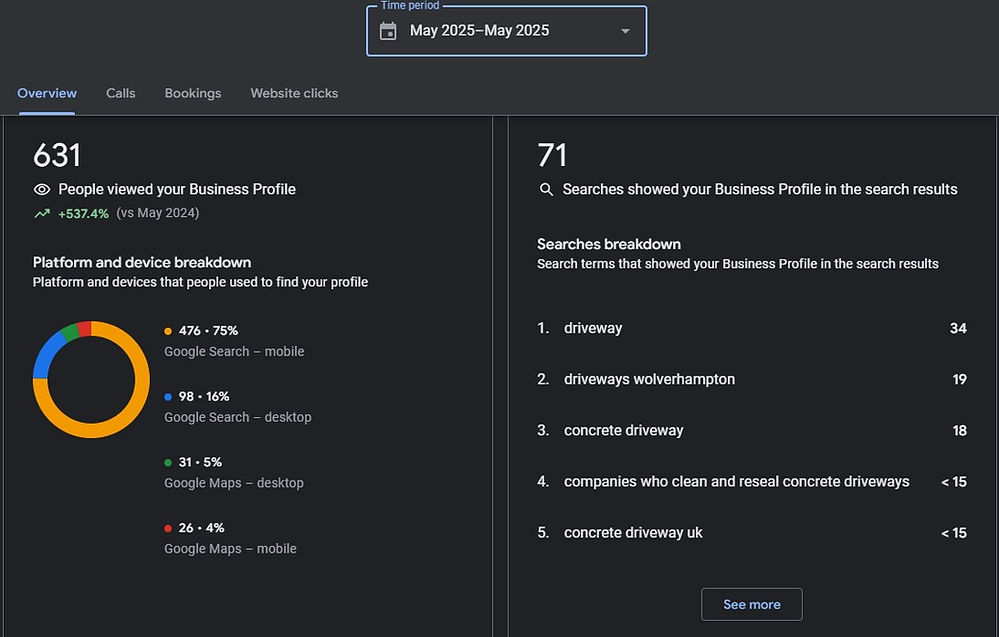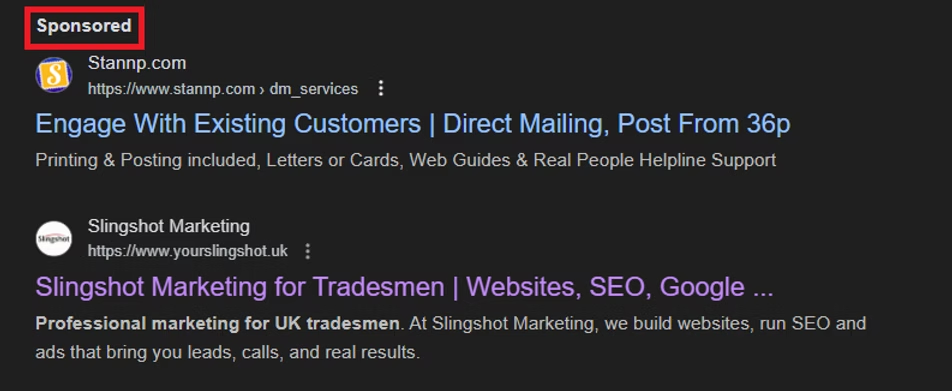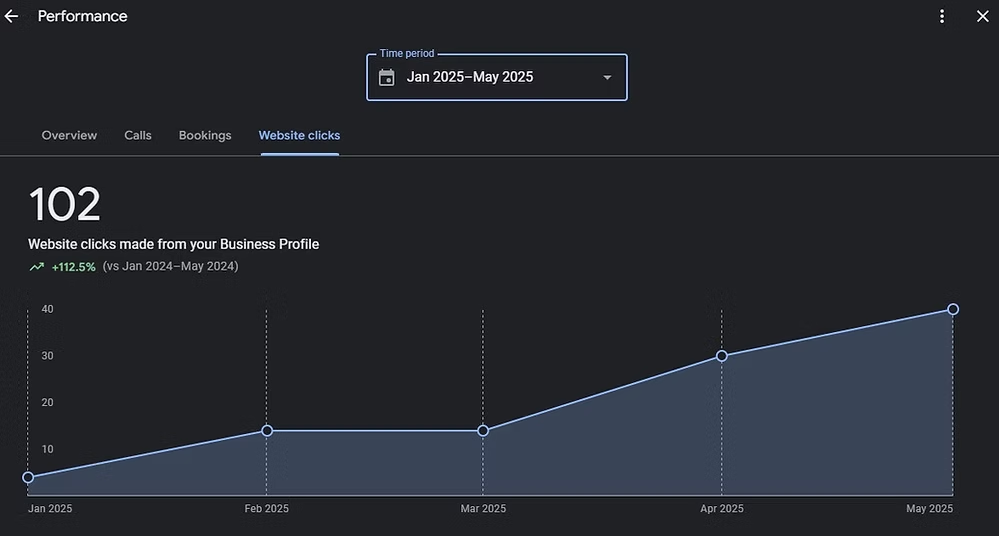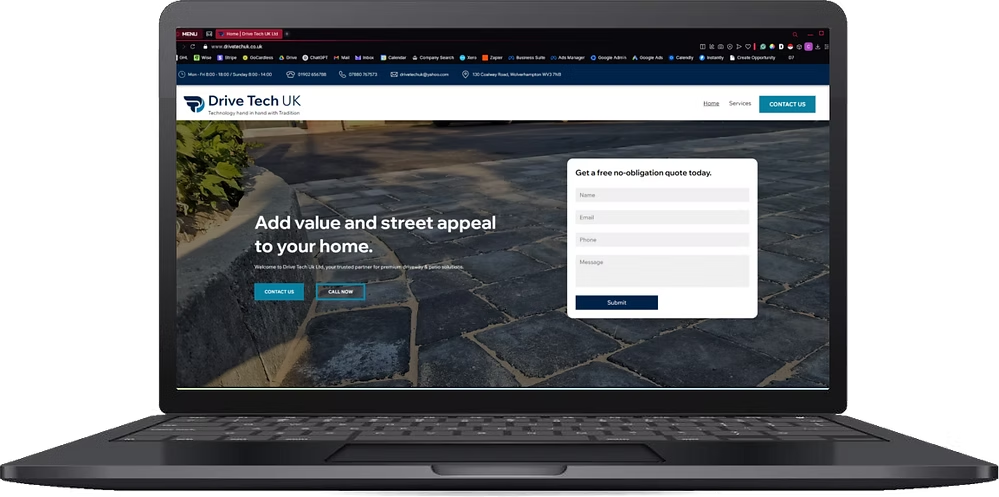If you’re a tradesman in the UK, getting found online is now just as important as doing a good job on site. Whether you’re a roofer, builder, electrician or landscaper, your next customer is likely to Google you or your services before they call.
There are two types of Google results: organic and paid. However, 94% of searchers scroll past the paid results and go straight to the organic, which is why SEO is better than Google PPC.
This guide walks you through the exact SEO process we follow at Slingshot Marketing to help our clients show up in search, attract better leads, and grow their businesses. It’s the same approach we use for roofers, driveway installers, plumbers, and other trade businesses across the country.
Even if you’re doing it yourself, this step-by-step guide will help you avoid common mistakes and start ranking properly.

1. Build a Professional Website
Your website is the foundation of your SEO. If it’s not built right, nothing else will work.
First Impressions Matter
When someone lands on your site, you’ve got seconds to prove you’re worth calling. If your site looks dated, messy, or slow, most people will leave.
Your website should look professional, match your branding, and be easy to navigate on mobile.
Conversion Optimisation
SEO is not just about traffic. It’s about turning that traffic into enquiries. Your site should include:
- Clear call-to-action (CTA) buttons like “Call Now” or “Get a Free Quote”
- Trust-building content such as reviews, accreditations, and case studies
- Multiple ways to contact you (form, phone, email, WhatsApp)
Don’t just try to impress. Build trust. That’s what gets calls.
SEO Built In
From day one, your site should be built with SEO in mind:
- Create separate service pages for each trade you offer
- Make it mobile friendly and fast loading
- Include proper meta titles and headings
- Add internal links between pages to help Google understand the site
2. Optimise Your Google Business Profile (GBP)
Your Google Business Profile (formerly Google My Business) is the first thing many people see when searching for a local tradesman.
Fill in Every Detail
Make sure your profile includes:
- A full business description with keywords
- Correct opening hours
- Service areas and categories
- A link to your website
Add real photos of your work, not stock images. Show before-and-after shots, vans with logos, or jobs in progress. This helps build trust.
Get Reviews
Ask every happy customer to leave a Google review. Even a handful of 5-star reviews can push you ahead of a competitor. We advise our clients to use business cards with a QR code overleaf which takes the customer directly to leave a review on Google, which is a massive help, and it’s easy to give them a card when you’ve finished your job.
More importantly, it shows Google and potential customers that you’re active and reliable.
If you’re not sure where to start, you can take a look at our Google Business Profile optimisation guide.

3. Use SEO Tools Like Semrush
You don’t need to guess what people are searching for. SEO tools like Semrush (and others) tell you the exact keywords homeowners use when looking for your service.
Track Local Keywords
Use local position tracking to see how your business ranks for terms like “fence repair in Crewe” or “boiler repair Macclesfield.”
This helps you track progress and find out which pages need more attention, as well as a few other figues like how much your traffic would cost if it were PPC, and the estimated volume of that search in your area.
Use On-Page SEO Tools
Semrush includes a tool called the On-Page SEO Checker. It gives you specific improvements for each page, like title tag changes, keyword usage, or internal link suggestions.
We use this tool on every homepage and service page we build for clients, to make sure that the metadata is keyword-focused, and to litter keywords and semantic phrases (phrases adjacent or related to our keyword that Google likes to see) throughout the pages.
Use Semrush Local
Semrush Local allows you to spread your Google Business Profile info across dozens of local directories. This is called local citation building – a key part of local SEO.
4. Get Backlinks
Backlinks are links from other websites that point to yours. Google sees these as “votes of confidence.” The more high-quality links you have, the more trusted your site becomes.
We build backlinks for all our SEO clients. Here’s how we do it:
Network-Based Links
You already know people in your trade:
- Suppliers
- Builders you’ve worked with
- Competitions you’ve entered
- Commercial projects you’ve helped complete
Ask them to link to your website if you’re featured, listed, or credited anywhere.
Local Relevance
Look for backlinks from local news publishers, event sponsors, or community websites. These links help show Google that you’re relevant in your area.
Some examples might include:
- Sponsoring a local youth team
- Being featured in a local business awards roundup
- Listing your business on local directories with SEO value
Topical Relevance
Try to get links from websites related to your trade. These could be:
- Construction industry blogs
- Trade magazines
- Product suppliers that list verified installers
For example, we got a client of ours featured in Grand Designs Magazine – a great quality and relevant backlink for them. You can read more example like that in our SEO Case Studies.
5. Build Topical Relevance
Google needs to understand that you’re an expert in your field. That’s where topical relevance comes in.
You do this by writing content that covers all aspects of your trade.
Create a Content Matrix
Don’t just guess what to write about. Create a plan.
At Slingshot, we use something called a content matrix. It helps you avoid keyword cannibalisation (when two pages fight for the same keyword) and ensures everything you write has a clear goal.
We write blogs that cover every stage of the customer journey, from “Do I need a rewire?” to “How much does rewiring cost?”
If you need inspiration, we’ve got a full list of SEO tips for tradesmen to get you started.
Write Relevant Topics
Some great blog topics include:
- The cost of your service in a local area
- Benefits of a particular material or method
- What to expect during the process
- Comparisons (e.g. resin vs tarmac, electric vs gas)
Once published, always request indexing in Google Search Console. It may take a few weeks for Google to pick it up.
You’ll find more in our SEO for Tradesmen Mythbusting post, especially if you’ve been told “blogging doesn’t work.”

6. Optimise Based on Data
Getting on Google is one thing. Staying there, and improving, is another.
Use Google Search Console
Check your impressions and clicks. Are people seeing your site but not clicking? It may be time to adjust your page titles or change your keywords.
Alternatively, you might be getting high impressions from a keyword you aren’t targeting yet, which tells you that you need to add a webpage and optimise for that search phrase.
Track Visitor Behaviour
Use tools like Google Analytics to see how people move around your site. Do they get stuck? Do they click your contact button?
This helps you tweak your layout, CTAs, and copy to improve conversions.
Even small changes, like moving a phone number to the top of the page, can increase calls.
Expand with New Info
Keep your site up to date. Add:
- New case studies
- New towns or areas you cover
- New services or qualifications
This shows Google you’re active and gives you more chances to rank.

Final Thoughts: SEO Is a System, Not a One-Off Task
SEO isn’t just a one-time job. It’s a system. It works best when each part supports the others.
At Slingshot Marketing, we don’t just build websites. We build complete systems that help tradesmen win more work online, from technical SEO and local targeting to regular content and backlinks.
Whether you’re doing it yourself or thinking of working with a team, following this step-by-step SEO guide will help your business get seen and stay ahead.



